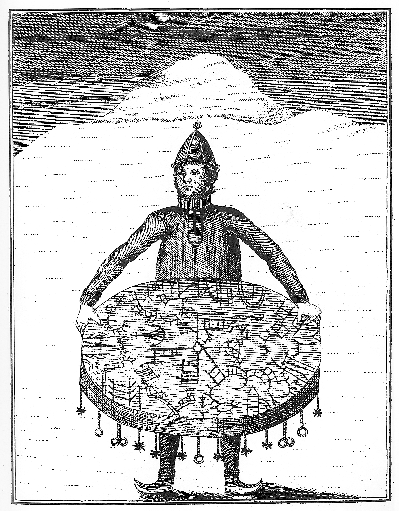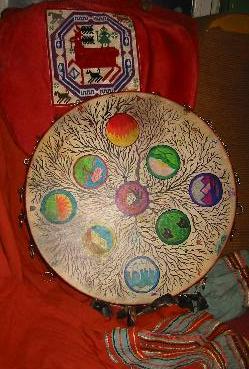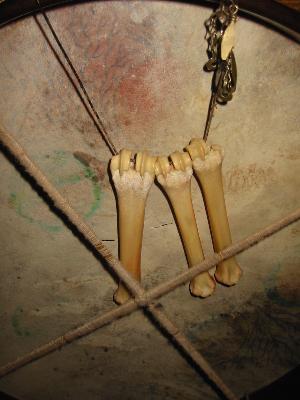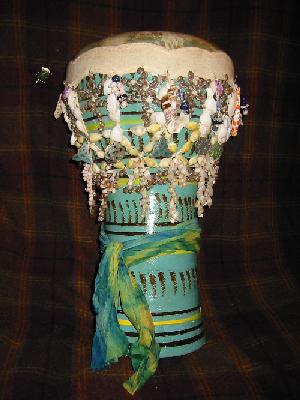Drums in Northern-Tradition Shamanism
excerpt from Wightridden: Paths of Northern-Tradition Shamanism

This article starts with a controversy, which I will describe and then sidestep. In many of the Norse/Germanic reconstructionist religious sects, there is debate over whether the early- medieval Nordic folk ever used drums as part of their religious ceremonies. (It's part and parcel of the argument over whether their religion was shamanic in nature.) There are a few vague references to things that could be seen as drumming, but nothing definitively conclusive.
As I've said before, I accept the fact that the Nordic religion of the "lore-period", which was mostly Christianized at that point anyway, does not have enough remnants of shamanic practice to accurately call it a shamanic religion. However, at one point far back in the pre- written-records past, it was. Some of those traditions and beliefs lingered, disguised in the later practices which were more suited to a society that found itself to be less about tribe and clan and more about city-states and agricultural nations. There was also the ambient knowledge that if anyone wished to learn shamanic religion or technique, all one had to do was to ask their Saami neighbors, who (not infrequently, according to historical sources) intermarried with the Norse people. The Saami did have a tradition of shamanism and drumming, and do to this day among their noiade.
All that aside - and here's that sidestep that I warned you about - when I began my training in earnest, I was told that I needed to have drums. Not just one, but three. Two are currently in my possession; the other is still to be made, and I will update this article when it comes into existence. I am still very much a novice in this study, and having noncorporeal teachers doesn't make it any easier.
There seem to be three kinds of drums in the shamanic tradition I am being taught that are useful to the modern-day shaman. The first type is a Worldwalker. These are generally flat frame drums, and are used both for moving between worlds and for doing divination. Its energy is a combination of Fire and Air. The second type is a healing drum, for healing rituals, and it is cylindrical, made of fired clay like the earth, although wood is a secondarily acceptable medium. Its energy is a combination of Earth and Water. The third is a large drum carved out of a single log, probably stationary, with a whole animal skin as a top. It is used for public ceremonies, and for calling the Dead. Its energy is Earth and Air.
I've been told that there were other sorts of drums long ago, but I have not been introduced to their energy. One was be the hunting drum, which the shaman uses to call the herds and the prey animals close to human habitation, so that the tribe would not starve. Its energy was Earth and Fire. Another was a weather drum, which could be used for calling or turning storms, but the spirits that it was associated with were dangerous and capricious, and playing it sometimes invited disaster. Its energy was Air and Water. Yet another drum was played for sexual fertility rites by the community; its energy was Fire and Water. In this article, I'll share my experiences with finding and using my own drums, as I was instructed by the Gods and spirits who I am apprenticed to.

The first drum had to be a frame drum. Size didn't seem to be important, but it had to be round or oval, broad and shallow and flat. It also had to be a gift. Fortunately my wife took the initiative and bought me a Pakistani frame drum from a shop for my birthday. I sat with that blank white surface and drummed it, experimenting with different beats, until I got my next instruction. I was supposed to hang things all around it, things that jingled and rattled. I experimented with different jangles over the next several months, trying them out and seeing if they brought the spirit's approval. (Generally I get a yes or a no pretty quickly, like within minutes.)
I ended up drilling tiny holes all around the exterior of the drum, and I attached tambourine jingles from another, broken drum. Each of the jingles conveniently had a dangling ring attached, and from then I hung more things - metal cone bells, a jangly metal earring given to me by a friend, an anklet of Indian bells from another friend, rattly beads. My friend Tannin of Bones and Flowers, who specializes in magical items made of bone and animal parts, cleaned and dried the hooves from four of the goat kids that we slaughtered, and I drilled them out and hung them on the drum as rattles. When my buck goat Phil died, she cleaned three of his shinbones for me, and I drilled the tops and hung them on the inside. I found that with this modification, I could hang the drum from one hand and walk, swinging it rhythmically, and Phil's bones would beat it for me. I had the distinct feeling that there was a little of Phil left in them, and that he very much liked being able to kick the drumhead. I jokingly called it "the drum that beats herself".

I was finally told what was to go on her head. I drew the World Tree, with the Nine Worlds around it. I drew it looking from the top down, and in its branches I drew dozens of tiny figures which came to me while half in trance. I wasn't sure what these were for, although I had the strong feeling that they were more than symbolically useful. This decoration, and all the jangles and hooves and bones, made me feel like my drum was some sort of bizarre mutant, especially when compared to the drums I saw in the hands of others. Most of the people that I met at Pagan gatherings, drum-and-dance groups, and the occasional powwow had drums that were Native American or African in style, or they had Celtic bodhrans. These were generally plain and streamlined and elegant. If there were designs on the top, they were spare and simple, and didn't cover the whole drumhead in a jumble of lines. Jingles or rattly decoration was considered tacky. I had never seen anything like what I had been told to make, and it worried me a little, especially when I would take my mutant drum out at drum circles and people would raise their eyebrows.
Much later, I read some anthropology and stumbled across the drum of the Saami shamans, which is called a runebom. While it can come in many sizes and levels of decoration, it is a frame drum, often hung with metal jangles and rattly bits. The pictures I saw had drumheads completely cluttered with seemingly random symbols, including usually drawings of a World Tree and at least three levels of worlds. I immediately recognized my bastard child, and realized that I was far from the first person to create a drum like this. I read that the tiny symbols drawn on the top were for a form of divination - a ring or tiny personal object was placed on the drumhead, and the shaman would beat the drum from underneath and do a reading from where the ring lands. "You're supposed to do that," said the spirit-voices in my ear.
The spirit of the drum was very feminine - both of my drums have been like that - and I did a ritual to ask her name, and formally name her. She had two names, Yggdrasil Moonsong. Yggdrasil for her first job, which is to be used to walk between the worlds. Moonsong for her divinatory abilities. The jingles were Air, and her beat was Fire. Although I have a piece of stag antler for a beater, I tend to play her with my hand anyway.

My second drum had to be made of wood or clay, and preferably clay. It didn't necessarily have to be a frame drum, so I used a clay doumbek from Greece - not northern, but then Yggdrasil Moonsong had originally hailed from Pakistan, so I suppose we first-re-generation shamans have to do the best we can with what we can get. She was also very feminine, even more so than my first drum, and was painted blue-green. My assistant Joshua spent hours hanging strings of shells on her (mostly culled from trashpicked macrame plant-hangers) until she had a gentle, delicate rattle whenever I played her. She's a healing drum, to be used for trances whereby one moves through the body of the client. When the summer comes, I will dip her base into the ocean, fully awakening her and finding her name.
I am not going to describe how to use a drum for the purposes I mention here, because there is no way to describe it in writing. If you are apprenticed to the spirits, they'll help you out, but generally the best way to learn is just to make and awaken the drum, and then work with it. Each drum, when awakened, has a spirit. It's alive. It can teach you things, but you have to put in the time and the attention. Don't worry about how to do it. Just do it. Learn what rhythms put you into what kind of trance by working with these creatures.
It should go without saying that you should treat your drums with respect. That means not ever neglecting them - it is said that a drum left alone without attention for a year and a day goes to sleep again and must be reawakened. It means taking care of them, and making sure that if for whatever reason you decide to no longer work with a drum, you must ask the spirits to find someone to give it to, someone who will value and use it. These are very much like your children, and you should give it as much thought as you would in giving up a child for adoption, if you got to pick the parents.
While we're talking about drums, I have to bring up the sticky point of rattles. I was told by the spirits that I am apprenticed to - flat out - that rattles are not part of our tradition. It wasn't that I couldn't own or use one, but they would not come for one, nor have anything to do with it. No rattles. Is there something wrong with a rattle, I asked? After all, it seems to have been adopted as the beginning shamanic practitioner's tool of choice, although perhaps that's because they are cheaper and easier to use than drums. The answer seemed to be that there was nothing particularly wrong with them, but that they were simply not part of our tradition. Period. "You won't need one," I was assured.
So, all right, no rattles. I concentrated on learning my drum, inside and out. And then, one night when I was very tired - hours of drumming will do that to you - I ended up exhausted enough that all I could do was to lay on my bed and rest the edge of the drum on my belly and shake it...and I discovered why I didn't need any rattles. The runebom-style drum is, in itself, a rattle as well. When I made my second drum and discovered that I was supposed to hang rattling shells all around her, I wasn't surprised. In this tradition, the drums are multipurpose instruments, and the different soundmakers call different things. And for some reason, the spirits are picky about that.

